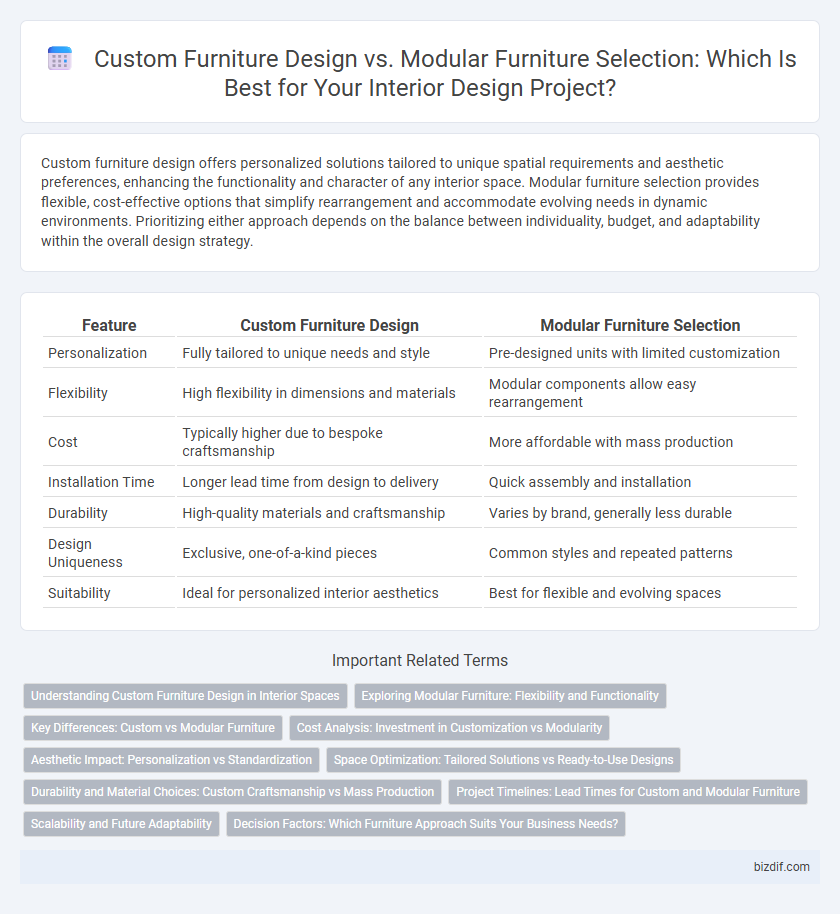Custom furniture design offers personalized solutions tailored to unique spatial requirements and aesthetic preferences, enhancing the functionality and character of any interior space. Modular furniture selection provides flexible, cost-effective options that simplify rearrangement and accommodate evolving needs in dynamic environments. Prioritizing either approach depends on the balance between individuality, budget, and adaptability within the overall design strategy.
Table of Comparison
| Feature | Custom Furniture Design | Modular Furniture Selection |
|---|---|---|
| Personalization | Fully tailored to unique needs and style | Pre-designed units with limited customization |
| Flexibility | High flexibility in dimensions and materials | Modular components allow easy rearrangement |
| Cost | Typically higher due to bespoke craftsmanship | More affordable with mass production |
| Installation Time | Longer lead time from design to delivery | Quick assembly and installation |
| Durability | High-quality materials and craftsmanship | Varies by brand, generally less durable |
| Design Uniqueness | Exclusive, one-of-a-kind pieces | Common styles and repeated patterns |
| Suitability | Ideal for personalized interior aesthetics | Best for flexible and evolving spaces |
Understanding Custom Furniture Design in Interior Spaces
Custom furniture design in interior spaces offers tailored solutions that perfectly match the unique dimensions, style, and functionality requirements of a room, enhancing spatial efficiency and aesthetic cohesion. It allows for the selection of premium materials and bespoke craftsmanship, ensuring durability and personalized character in every piece. This approach contrasts with modular furniture, which prioritizes flexibility and mass production but may lack the distinctiveness and precise fit of custom-designed elements.
Exploring Modular Furniture: Flexibility and Functionality
Modular furniture offers unparalleled flexibility, allowing users to easily reconfigure pieces to suit changing needs and spaces, making it ideal for dynamic living environments. Its functionality is enhanced by interchangeable components that optimize space utilization and provide customizable storage solutions. This adaptability contrasts with custom furniture design, which offers tailored aesthetics but lacks the ease of modification inherent in modular systems.
Key Differences: Custom vs Modular Furniture
Custom furniture design offers personalized dimensions, materials, and styles tailored to individual preferences, enhancing unique interior aesthetics. Modular furniture selection provides adaptable, mass-produced units that prioritize flexibility, ease of assembly, and cost efficiency. Key differences include customization level, durability, and scalability, with custom pieces often delivering higher craftsmanship and exclusivity compared to the standardized, versatile nature of modular options.
Cost Analysis: Investment in Customization vs Modularity
Custom furniture design often entails higher initial costs due to bespoke craftsmanship, premium materials, and tailored dimensions, which can increase overall investment but yield unique, personalized interiors. Modular furniture selection typically offers cost-effective solutions with standardized components that simplify manufacturing and assembly, reducing upfront expenses while enhancing flexibility for future reconfiguration. Evaluating long-term value involves considering customization premiums against modular adaptability and potential savings on replacement or redesign.
Aesthetic Impact: Personalization vs Standardization
Custom furniture design offers unparalleled aesthetic impact through personalized craftsmanship, allowing tailored materials, colors, and styles that reflect individual tastes and interior themes. Modular furniture selection provides a streamlined, standardized look with interchangeable components that ensure consistency and functional adaptability across diverse spaces. The choice between customization and modularity directly influences the interior's visual uniqueness versus cohesive uniformity.
Space Optimization: Tailored Solutions vs Ready-to-Use Designs
Custom furniture design maximizes space optimization by providing tailored solutions that fit unique room dimensions and functional needs, ensuring every inch is utilized efficiently. Modular furniture selection offers ready-to-use designs that allow flexibility and easy reconfiguration but may lack the precise fit and personalization of custom pieces. Prioritizing custom design enhances spatial harmony and storage capacity, especially in irregular or compact interiors.
Durability and Material Choices: Custom Craftsmanship vs Mass Production
Custom furniture design offers superior durability through handcrafted techniques and premium materials tailored to specific needs, ensuring long-lasting quality and unique aesthetics. In contrast, modular furniture selection often relies on mass production methods using standardized materials like particleboard or MDF, which can compromise longevity for affordability and ease of assembly. The choice between custom craftsmanship and modular options significantly impacts material performance and the furniture's lifespan within interior design projects.
Project Timelines: Lead Times for Custom and Modular Furniture
Custom furniture design typically requires longer lead times, often ranging from 8 to 16 weeks due to the detailed craftsmanship and personalized specifications involved. Modular furniture selection offers shorter project timelines, with availability usually within 2 to 4 weeks, making it ideal for fast-tracked interior projects. Efficient project planning must consider these lead times to ensure timely installation and overall schedule adherence in interior design projects.
Scalability and Future Adaptability
Custom furniture design offers unparalleled scalability and future adaptability by allowing pieces to be tailored precisely to evolving spatial needs and aesthetic preferences. Modular furniture selection provides flexible scalability through interchangeable components that can be reconfigured or expanded to accommodate changing environments. Both approaches emphasize adaptability, but custom designs deliver unique, space-optimized solutions while modular systems prioritize ease of modification and incremental growth.
Decision Factors: Which Furniture Approach Suits Your Business Needs?
Custom furniture design offers tailored solutions that perfectly align with a business's spatial constraints and branding requirements, providing unique pieces that enhance identity and functionality. Modular furniture selection emphasizes flexibility, ease of installation, and scalability, ideal for businesses anticipating growth or frequent layout changes. Key decision factors include budget constraints, desired aesthetic, space optimization, and the need for adaptability in evolving work environments.
Custom Furniture Design vs Modular Furniture Selection Infographic

 bizdif.com
bizdif.com